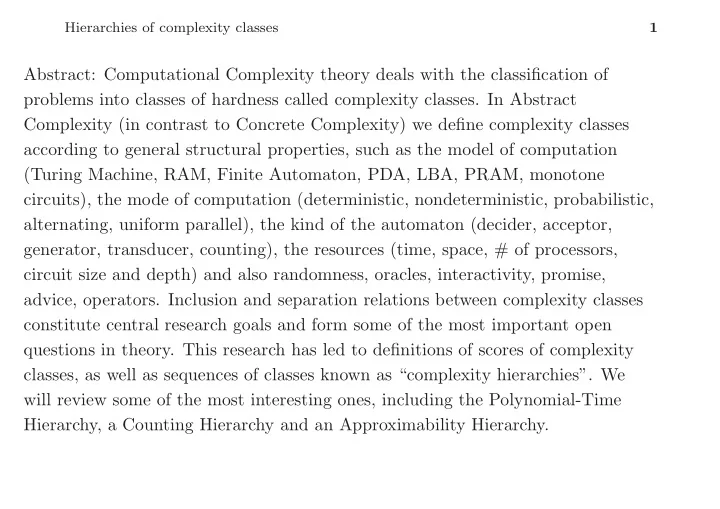

Hierarchies of complexity classes 1 Abstract: Computational Complexity theory deals with the classification of problems into classes of hardness called complexity classes. In Abstract Complexity (in contrast to Concrete Complexity) we define complexity classes according to general structural properties, such as the model of computation (Turing Machine, RAM, Finite Automaton, PDA, LBA, PRAM, monotone circuits), the mode of computation (deterministic, nondeterministic, probabilistic, alternating, uniform parallel), the kind of the automaton (decider, acceptor, generator, transducer, counting), the resources (time, space, # of processors, circuit size and depth) and also randomness, oracles, interactivity, promise, advice, operators. Inclusion and separation relations between complexity classes constitute central research goals and form some of the most important open questions in theory. This research has led to definitions of scores of complexity classes, as well as sequences of classes known as “complexity hierarchies”. We will review some of the most interesting ones, including the Polynomial-Time Hierarchy, a Counting Hierarchy and an Approximability Hierarchy.
Hierarchies of complexity classes 2 30’s, 40’s: Unsolvability G¨ odel, Kleene ANALYTICAL ARITHMETICAL coRE RE REC PrimREC Elementary
Hierarchies of complexity classes 3
Hierarchies of complexity classes 4 Kalmar Elementary : Loop-Computable with number of nested for-loops ≤ 2 PrimREC : Primitive Recursive, Loop-Computable REC : Recursive, Decidable, Computable RE : Recursively Enumerable, Listable, Acceptable ARITHMETICAL : Definable in Arithmetic: N = � N ; < ; S ; +; ∗ ; 0 � . Definable by first-order quantified formula over a recursive predicate. E.g.: ∃ x 1 ∀ x 2 ∃ x 3 . . . R ( x 1 , . . . , x k ) ∈ Σ 0 k ANALYTICAL : Definable by a second-order quantified formula. E.g., ∃ set A , ∀ function f , . . .
Hierarchies of complexity classes 5 50’s: Formal Languages and Automata Chomsky Deterministic vs. Nondeterministic Model Relation of C with coC � = coRE RE = coCS CS CF � = coCF = coREG REG FIN � = coFIN
Hierarchies of complexity classes 6
Hierarchies of complexity classes 7 FIN : finite REG : decidable (acceptable) by a (Deterministic or Nondeterministic) Finite Automaton, equivalently definable by a Regular Expression, equivalently generatable by a Right-Linear Grammar CF : decidable (acceptable) by a (Nondeterministic) Push-Down Automaton, equivalently generatable by a Context-Free Grammar CS : decidable (acceptable) by a (Nondeterministic) Linearly-Bounded Automaton, equivalently generatable by a Context-Sensitive Grammar RE : acceptable by a (Deterministic or Nondeterministic) Turing Machine, equivalently generatable by a General Grammar
Hierarchies of complexity classes 8 60’s: Computational Complexity (Space, Time) Hartmanis PrimREC SUPEREXPTIME EXPTIME PSPACE P CS CF L REG
Hierarchies of complexity classes 9
Hierarchies of complexity classes 12
Hierarchies of complexity classes 13 early 70’s: Nondeterminism and Complexity NP-completeness Cook, Karp, Savitch PSPACE = NPSPACE NP P NL L
Hierarchies of complexity classes 14
Recommend
More recommend